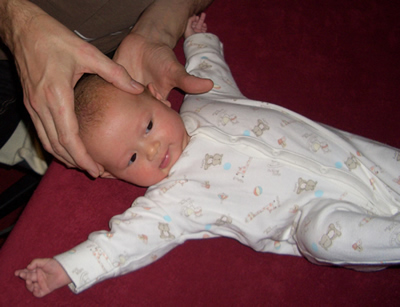What is Cranial Osteopathy?
Cranial Osteopathy is an osteopathic treatment for the reduction of stress and tension, allowing relaxation throughout the whole body. It is effective in resolving a wide range of problems in people of all ages from the very young to the very old. It is extremely gentle
which makes it ideal for the sensitive and the fragile. It isan excellent antidote for all types of stress and trauma.

Cranial treatment is based on something called involuntary motion or Cranial Rhythm,
a subtle pulsing of fluids in the brain, body and spinal cord. These can be felt in tiny movements of the skull and at the back of the pelvis, by a well trained osteopathic practitioner. The quality of this motion is a good indicator of health, as the fluids involved are central to the mechanisms the body uses to maintain health.
Stress in the form of trauma, overwork, bad posture or excessive worries can have an adverse effect on the cranial rhythm. The skilled practitioner can influence a disrupted rhythm, returning it to a balanced equilibrium. The effect of this is to decrease stress and restore health
What does cranial treatment involve?
In the hands of a trained Osteopath the format will involve an in depth diagnosis followed by treatment and advice on how to make the best of the positive changes that have occured.
An initial interview will seek to fully understand the issues that the patient wishes to resolve.
The health background and anything that could affect the treatment outcome will be discussed. This is followed by an osteopathic examination that can confirm the findings from the interview and identify specific postural and musculo skeletal issues. At this point the Osteopath may also do any special tests that could help in a complete and accurate diagnosis. Once diagnosis is complete the cranial assessment and treatment can begin.
Cranial Assessment
With the patient lying face up on the treatment couch the osteopath sits at their head with his hands cupped under the base of the skull. Although it may feel that the practitioner is not doing much, they are actually carefully sensing the tiny cranial movements that give an indication of the body's overall health and vitality (known are the cranial rhythm). The patient may notice an increasing feeling of well being at this point, as well as a deepening sense of relaxation.
Cranial Treatment
Having accustomed themselves to the patients cranial rhythm the practitioner will use very subtle and gentle changes in pressure at key moments during the cycle to subtly influence the rhythm, slowly bringing it into a more balanced and synchronised state. It is not uncommon for the patient to fall asleep during this time. Later on the treatment may also involve the osteopath positioning their hands at the base of the back and between the shoulder blades to treat the cranial rhythm in a slightly different way. The whole treatment will last between 15 minutes and half an hour, during which profound changes can take place. At the end the patient will usually feel relaxed and revitalised
After the treatment
If there have been fairly major adjustments then it may take some time for the body to adjust
the patient may feel a bit tired for a day or 2 as toxins are eliminated and the body gets used to functioning in a different way. During this time it is usually helpful to drink more water and eat more natural food, especially whole grains and vegetables. Once recovered many patients report great improvements in their sense of wellness and vitality, as well as improvements in the issues that were treated.
What is it useful for?
Cranial treatment has been effectively applied in a wide range of medical conditions
covering anything from mild stress to IBS, Crohns disease and chronic pain syndrome. It is used extensively in treating children with behavioral problems and babies with problem
sleeping, feeding and crying. It is also very useful for treating chronic stress and for treating the elderly and infirm.
Who can do it?
A qualified Osteopath who has been specifically trained in cranial methods will have the broadest and deepest training in effective diagnosis and cranial treatment . There are many practitioners who have trained very briefly, and who may not be fully versed in the range and issues that patients could present with. A qualified osteopath will have a complete knowledge of all the bodily systems, will be trained to recognise a wide range of medical conditions. They will also be specifically trained in careful interview and examination techniques to ensure that the chosen treatment is well suited to your needs. A GOsc registered osteopath will be also certified as safe and effective.
